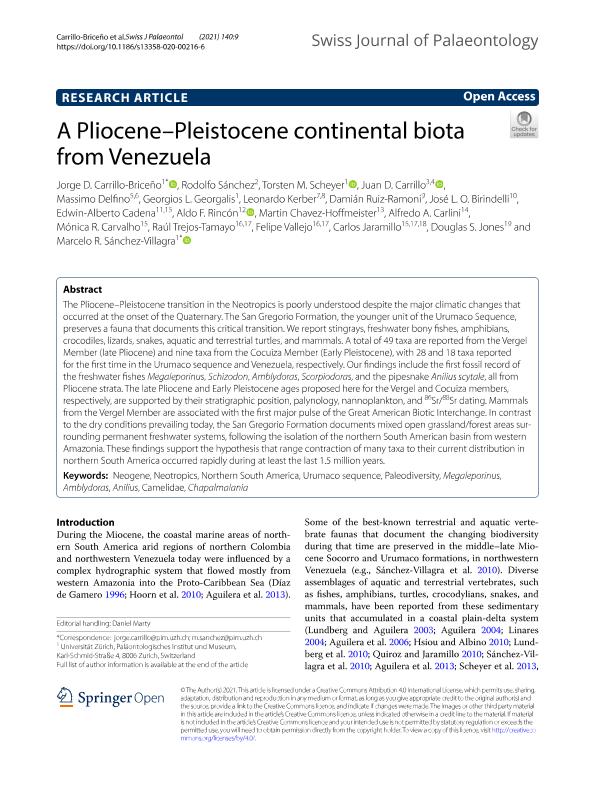Artículo
A Pliocene–Pleistocene continental biota from Venezuela
Carrillo Briceño, Jorge D.; Sánchez, Rodolfo; Scheyer, Torsten M.; Carrillo, Juan D.; Delfino, Massimo; Giorgios, Georgios L.; Kreber, Leonardo; Ruiz Ramoni, Damián ; Birindelli, José L. O.; Cadena, Edwin Alberto; Rincón, Aldo F.; Chavez Hofmeister, Martin; Carlini, Alfredo Armando
; Birindelli, José L. O.; Cadena, Edwin Alberto; Rincón, Aldo F.; Chavez Hofmeister, Martin; Carlini, Alfredo Armando ; Carvalho, Mónica R.; Trejos Tamayo, Raúl; Vallejo, Felipe; Jaramillo, Carlos; Jones, Douglas S.; Sánchez Villagra, Marcelo Ricardo
; Carvalho, Mónica R.; Trejos Tamayo, Raúl; Vallejo, Felipe; Jaramillo, Carlos; Jones, Douglas S.; Sánchez Villagra, Marcelo Ricardo
 ; Birindelli, José L. O.; Cadena, Edwin Alberto; Rincón, Aldo F.; Chavez Hofmeister, Martin; Carlini, Alfredo Armando
; Birindelli, José L. O.; Cadena, Edwin Alberto; Rincón, Aldo F.; Chavez Hofmeister, Martin; Carlini, Alfredo Armando ; Carvalho, Mónica R.; Trejos Tamayo, Raúl; Vallejo, Felipe; Jaramillo, Carlos; Jones, Douglas S.; Sánchez Villagra, Marcelo Ricardo
; Carvalho, Mónica R.; Trejos Tamayo, Raúl; Vallejo, Felipe; Jaramillo, Carlos; Jones, Douglas S.; Sánchez Villagra, Marcelo Ricardo
Fecha de publicación:
05/2021
Editorial:
Springer
Revista:
Swiss Journal of Palaeontology
ISSN:
1664-2376
e-ISSN:
1664-2384
Idioma:
Inglés
Tipo de recurso:
Artículo publicado
Clasificación temática:
Resumen
The Pliocene–Pleistocene transition in the Neotropics is poorly understood despite the major climatic changes that occurred at the onset of the Quaternary. The San Gregorio Formation, the younger unit of the Urumaco Sequence, preserves a fauna that documents this critical transition. We report stingrays, freshwater bony fishes, amphibians, crocodiles, lizards, snakes, aquatic and terrestrial turtles, and mammals. A total of 49 taxa are reported from the Vergel Member (late Pliocene) and nine taxa from the Cocuiza Member (Early Pleistocene), with 28 and 18 taxa reported for the first time in the Urumaco sequence and Venezuela, respectively. Our findings include the first fossil record of the freshwater fishes Megaleporinus, Schizodon, Amblydoras, Scorpiodoras, and the pipesnake Anilius scytale, all from Pliocene strata. The late Pliocene and Early Pleistocene ages proposed here for the Vergel and Cocuiza members, respectively, are supported by their stratigraphic position, palynology, nannoplankton, and 86Sr/88Sr dating. Mammals from the Vergel Member are associated with the first major pulse of the Great American Biotic Interchange. In contrast to the dry conditions prevailing today, the San Gregorio Formation documents mixed open grassland/forest areas surrounding permanent freshwater systems, following the isolation of the northern South American basin from western Amazonia. These findings support the hypothesis that range contraction of many taxa to their current distribution in northern South America occurred rapidly during at least the last 1.5 million years.
Archivos asociados
Licencia
Identificadores
Colecciones
Articulos(CCT - LA PLATA)
Articulos de CTRO.CIENTIFICO TECNOL.CONICET - LA PLATA
Articulos de CTRO.CIENTIFICO TECNOL.CONICET - LA PLATA
Articulos(CRILAR)
Articulos de CENTRO REGIONAL DE INV. CIENTIFICAS Y TRANSFERENCIA TECNOLOGICA DE ANILLACO
Articulos de CENTRO REGIONAL DE INV. CIENTIFICAS Y TRANSFERENCIA TECNOLOGICA DE ANILLACO
Citación
Carrillo Briceño, Jorge D.; Sánchez, Rodolfo; Scheyer, Torsten M.; Carrillo, Juan D.; Delfino, Massimo; et al.; A Pliocene–Pleistocene continental biota from Venezuela; Springer; Swiss Journal of Palaeontology; 140; 5-2021; 1-76
Compartir
Altmétricas



